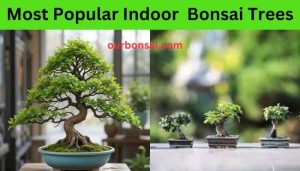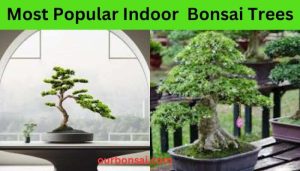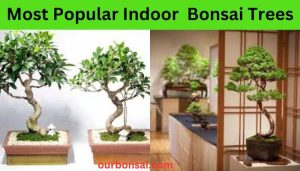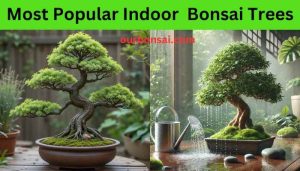Discover the most popular indoor bonsai trees that thrive inside your home. From low-maintenance options to stunning miniature masterpieces, find the perfect bonsai for your space. Explore expert care tips and the best species for beginners and enthusiasts alike!
Table of Contents
ToggleIndoor bonsai trees add a touch of nature to your home. They are small, beautiful, and easy to care for.
Bonsai trees have captivated plant lovers for centuries. Their miniature size and intricate beauty make them popular choices for indoor gardening. Whether you are a beginner or a seasoned enthusiast, indoor bonsai trees offer a unique way to bring the outdoors inside.
These living art pieces not only enhance your home decor but also provide a calming presence. Perfect for small spaces, they require minimal maintenance while offering endless aesthetic appeal.

In this blog, we explore the most popular indoor bonsai trees that can transform your living space into a serene oasis. Discover which varieties are best suited for beginners and why these tiny trees are so special.
Most Popular Indoor Bonsai Trees
Ficus, Jade, and Chinese Elm are among the most popular indoor bonsai trees. They thrive in low light and are easy to care for. These trees add beauty and tranquility to any indoor space.
Indoor bonsai trees bring nature into your home. These miniature trees add a touch of serenity and beauty to any space. Let’s explore some of the most popular indoor bonsai trees.
Ficus Bonsai, Most Popular Indoor Bonsai Trees
Ficus bonsai trees are perfect for beginners. They are hardy and adaptable.
- Light requirement: Bright, indirect light.
- Watering: Keep the soil moist, but not soggy.
- Pruning: Regular trimming to maintain shape.
Jade Bonsai
Jade bonsai trees are easy to care for. Their thick leaves store water.
- Light requirement: Full sun to partial shade.
- Watering: Allow the soil to dry between waterings.
- Pruning: Trim branches to encourage growth.
Chinese Elm Bonsai | Most Popular Indoor Bonsai Trees
Chinese Elm bonsai are popular for their elegant appearance. They have small leaves and fine branches.
- Light requirement: Bright light, some direct sun.
- Watering: Keep the soil consistently moist.
- Pruning: Regular pruning for structure.
Japanese Maple Bonsai
Japanese Maple bonsai are known for their vibrant leaves. They change color with the seasons.
- Light requirement: Bright, indirect light.
- Watering: Keep the soil moist, but not waterlogged.
- Pruning: Trim during the growing season.
Dwarf Schefflera Bonsai
Dwarf Schefflera bonsai are tropical plants. They have lush, green foliage.
- Light requirement: Bright, indirect light.
- Watering: Keep the soil evenly moist.
- Pruning: Prune to maintain the desired shape.

Serissa Bonsai
Serissa bonsai are also called “Tree of a Thousand Stars. ” They produce small, white flowers.
- Light requirement: Bright light with some direct sun.
- Watering: Keep the soil moist, avoid drying out.
- Pruning: Prune to encourage flowering.
Sago Palm Bonsai
Sago Palm bonsai have a unique, tropical look. They are slow-growing and long-lived.
- Light requirement: Bright, indirect light.
- Watering: Allow the soil to dry between waterings.
- Pruning: Remove yellowing leaves to maintain health.
Hawaiian Umbrella Bonsai
Hawaiian Umbrella bonsai are low-maintenance. They are perfect for beginners.
- Light requirement: Bright, indirect light.
- Watering: Keep the soil evenly moist.
- Pruning: Prune to control size and shape.
Choose the right bonsai for your space. Enjoy the beauty and tranquility they bring.
Top 10 Most Popular Indoor Bonsai Trees For Beginners
Discover the top 10 most popular indoor bonsai trees perfect for beginners. These trees are easy to care for and enhance any indoor space. Ideal choices include the Ficus, Jade, and Chinese Elm.
Indoor bonsai trees bring natural beauty into homes. They are perfect for beginners. Let’s explore the top 10 most popular indoor bonsai trees for those starting out.
Ficus Bonsai
Ficus Bonsai is a favorite among beginners. It is easy to care for and tolerates low light.
Chinese Elm Bonsai
Chinese Elm Bonsai trees are known for their small leaves and elegant shape. Here are some reasons why they are popular:
- Easy to prune: Keeps its shape well.
- Disease-resistant: Lower chances of plant diseases.
- Adaptable: Thrives in various indoor conditions.
Jade Bonsai, Most Popular Indoor Bonsai Trees
Jade Bonsai, also known as the Money Plant, is a popular choice. It has thick, glossy leaves and requires minimal watering.
Juniper Bonsai
Juniper Bonsai is very beginner-friendly. Here are its main benefits:
- Hardy: Can survive in various conditions.
- Minimal pruning: Maintains its shape easily.
- Attractive appearance: Beautiful needle-like leaves.
Serissa Bonsai
Serissa Bonsai, also called the Tree of a Thousand Stars, is loved for its small, white flowers. It needs regular watering but is otherwise easy to manage.
Schefflera Bonsai
Schefflera Bonsai, or Dwarf Umbrella Tree, has unique umbrella-shaped leaves. It is highly adaptable and requires minimal care.

Fukien Tea Bonsai
Fukien Tea Bonsai is a great indoor tree for beginners. Its benefits include:
- Small white flowers: Adds beauty throughout the year.
- Easy to prune: Can be shaped easily.
- Tolerates indoor conditions: Thrives well inside homes.
Hawaiian Umbrella Bonsai
Hawaiian Umbrella Bonsai is a sturdy and low-maintenance tree. It has shiny, dark green leaves that add a tropical feel to any space.
Dwarf Pomegranate Bonsai
Dwarf Pomegranate Bonsai trees are admired for their bright flowers and small fruit. They need regular watering but are otherwise easy to care for.
Bamboo Bonsai
Bamboo Bonsai brings an exotic touch to indoor spaces. Key advantages include:
- Fast growth: Quickly fills out its pot.
- Easy to shape: Can be styled in various ways.
- Resilient: Adapts well to indoor environments.
By choosing any of these bonsai trees, beginners can enjoy the beauty and tranquility of bonsai gardening with ease.
Popular Indoor Bonsai Trees For Beginners
Ficus, Jade, and Chinese Elm are among the most popular indoor bonsai trees for beginners. These trees are easy to care for and thrive indoors.
Exploring the world of indoor bonsai trees can be both exciting and rewarding. Whether you’re new to bonsai or just looking for a new addition to your home, there are several trees perfect for beginners. These trees are easy to care for and can thrive indoors.
Ficus Bonsai, Most Popular Indoor Bonsai Trees
The Ficus is a popular choice for beginners.
- Easy to care for: Requires minimal maintenance.
- Tolerant of low humidity: Perfect for indoor environments.
- Fast-growing: Provides quick gratification.
Jade Bonsai
Jade Bonsai is another excellent option for novices. This tree is known for its thick, lush leaves.
- Drought-tolerant: Can survive with infrequent watering.
- Slow-growing: Requires less frequent pruning.
- Attractive appearance: Adds a touch of elegance to any room.
Chinese Elm Bonsai
Chinese Elm is great for beginners. It’s one of the hardiest bonsai trees.
- Versatile: Can be grown indoors or outdoors.
- Tolerant of pruning: Easy to shape and maintain.
- Attractive bark: Adds visual interest.
Hawaiian Umbrella Bonsai
This tree is perfect for those new to bonsai. The Hawaiian Umbrella Bonsai is very forgiving.
- Low light tolerance: Thrives in various lighting conditions.
- Minimal watering needs: Ideal for busy individuals.
- Dense foliage: Creates a lush, tropical feel.
Juniper Bonsai, Most Popular Indoor Bonsai Trees
Juniper Bonsai is a classic choice. It’s well-suited for beginners.
- Hardy species: Can withstand a variety of conditions.
- Easy to shape: Perfect for practicing bonsai techniques.
- Evergreen leaves: Provides year-round greenery.

Each of these indoor bonsai trees offers unique benefits. They are all perfect for beginners and can bring nature into your home.
Most Popular Indoor Bonsai Trees For Beginners
Ficus Bonsai and Jade Bonsai are top choices for beginners. They are easy to care for and thrive indoors. Perfect for adding a touch of nature to your home.
Cultivating indoor bonsai trees can be a rewarding experience. For beginners, choosing the right tree is crucial for success. Here are some of the most popular indoor bonsai trees that are perfect for those new to this art.
Ficus Bonsai
The Ficus Bonsai is ideal for beginners due to its hardiness. This tree can thrive in various indoor conditions and requires minimal care.
- Low maintenance: Suitable for busy individuals.
- Tolerates low light: Perfect for indoor environments.
- Grows quickly: Visible progress keeps motivation high.
Jade Bonsai
Jade Bonsai is a succulent that is easy to care for. Its thick, shiny leaves and sturdy trunk make it a favorite among beginners.
This tree needs only a little water and can survive in dry indoor air. Jade Bonsai is also known for its ability to thrive in a variety of light conditions.
Chinese Elm Bonsai
Chinese Elm Bonsai is another great option for novices. It adapts well to indoor settings and has a graceful appearance.
- Easy to shape: Good for practicing pruning techniques.
- Tolerates various light levels: Flexible placement options.
- Requires regular watering: Establishes a consistent care routine.
Juniper Bonsai
Juniper Bonsai is often recommended for beginners. This type of bonsai can be trained into different styles and is quite resilient.
It’s important to note that Juniper prefers a bit more sunlight, so placing it near a window is ideal. This tree can handle some neglect, making it forgiving for those still learning.
Hawaiian Umbrella Bonsai
The Hawaiian Umbrella Bonsai is known for its durability and unique foliage. It is an excellent choice for those just starting with bonsai.
- Compact size: Fits well in small spaces.
- Low light tolerance: Suitable for indoor settings.
- Resilient nature: Withstands beginner mistakes.
Dwarf Schefflera Bonsai
Dwarf Schefflera Bonsai is popular for its lush, green leaves. This tree is both beautiful and easy to care for, making it a top pick for beginners.
Its ability to thrive in low light and its minimal watering needs make it a convenient option for indoor environments. The Dwarf Schefflera Bonsai is a reliable choice for those new to bonsai care.
Most Beautiful Bonsai Tree In The World
The Fukien Tea Tree is often hailed as the most beautiful bonsai tree in the world. Known for its glossy leaves and delicate white flowers, it remains one of the most popular indoor bonsai trees.
Bonsai trees bring beauty and serenity into any indoor space. One particular bonsai tree stands out as the most beautiful in the world.
Japanese Maple Bonsai
The Japanese Maple Bonsai captivates with its delicate leaves and vibrant colors. It’s a favorite among bonsai enthusiasts for many reasons:
- Stunning foliage: The leaves change color with the seasons.
- Graceful branches: The branches have an elegant, flowing shape.
- Varied sizes: Suitable for small spaces or larger displays.
Cherry Blossom Bonsai
Cherry Blossom Bonsai trees are known for their exquisite flowers. These bonsai trees create a peaceful and visually stunning display:
- Beautiful blooms: Pink and white blossoms appear in the spring.
- Fragrant flowers: The flowers emit a gentle, pleasing scent.
- Symbolic meaning: Represents renewal and the beauty of life.

Juniper Bonsai
Another beautiful bonsai tree is the Juniper Bonsai. It offers a mix of beauty and ease of care. Juniper Bonsai trees are ideal for beginners:
- Hardy nature: Can withstand various indoor conditions.
- Evergreen foliage: Keeps its color year-round.
- Artful shapes: Easily shaped into intricate designs.
Bougainvillea Bonsai
Bougainvillea Bonsai trees are perfect for adding a splash of color. These trees are both striking and low-maintenance:
- Bright bracts: Vibrant pink, purple, or orange bracts.
- Drought-tolerant: Requires minimal watering.
- Fast-growing: Quickly develops into a beautiful display.
Ficus Bonsai
Ficus Bonsai trees are popular for their robust nature and attractive appearance. They are a staple in many bonsai collections:
- Thick trunk: Gives a mature and sturdy look.
- Aerial roots: Adds an exotic touch.
- Versatile care: Thrives in various indoor environments.
Each of these bonsai trees offers unique beauty and charm. They enhance any indoor space, bringing nature’s elegance into your home.
Why Are Bonsai Trees So Special
Bonsai trees are admired for their beauty and tranquility. Popular indoor bonsai types include the Ficus, Jade, and Chinese Elm. Their compact size makes them perfect for small spaces, adding a touch of nature indoors.
Bonsai trees are miniature marvels that captivate with their beauty and tranquility. These tiny trees are more than just plants; they represent art, patience, and nature’s balance.
Historical Significance
Bonsai trees have a rich history. Originating in China over a thousand years ago, they were later refined by the Japanese. They symbolize harmony, peace, and balance.
Artistic Expression
Cultivating bonsai is an art form. It involves shaping and nurturing the tree to create a miniature version of a full-sized tree. This process requires creativity and vision, making each bonsai unique.
Therapeutic Benefits
Many people find caring for bonsai trees calming. Engaging with bonsai can reduce stress and improve mental well-being. Here are some reasons why:
- Mindfulness practice: Caring for a bonsai requires attention and care.
- Stress relief: The slow growth and delicate nature of bonsai promote relaxation.
- Sense of accomplishment: Watching a bonsai thrive provides satisfaction.
Connection To Nature
Bonsai trees bring a piece of nature indoors. They allow people to connect with the natural world, even in urban settings. This connection helps create a peaceful environment in homes and offices.
Educational Value
Bonsai trees offer learning opportunities. They teach patience, attention to detail, and the importance of nurturing. Beginners and experts alike can enjoy the journey of bonsai cultivation.
Diverse Varieties
There are many types of bonsai trees. Each variety has its unique characteristics and care requirements. Some popular indoor bonsai trees include:
- Ficus: Known for its resilience and adaptability.
- Jade: Appreciated for its thick, succulent leaves.
- Chinese Elm: Valued for its elegant, slender branches.
Long Lifespan
With proper care, bonsai trees can live for many years. Some bonsai are passed down through generations, becoming cherished family heirlooms. This longevity adds to their special appeal.

Cultural Significance
In many cultures, bonsai trees hold symbolic meanings. They are often associated with harmony, balance, and longevity. This cultural significance enhances their value and appeal.
Aesthetic Appeal
Bonsai trees are visually stunning. Their intricate shapes and miniature size create a sense of wonder. They can enhance the aesthetic of any space, making them a popular choice for interior decoration.
Environmental Impact
Bonsai trees are eco-friendly. They require minimal resources and can thrive in small spaces. This makes them a sustainable choice for plant enthusiasts.
In essence, bonsai trees are special due to their rich history, artistic nature, and the myriad of benefits they provide. They offer a unique blend of beauty, tranquility, and connection to nature that few other plants can match.
What Is The Most Popular Bonsai Tree?
The Ficus bonsai tree stands out as a favorite for indoor settings. Its resilience and ease of care make it ideal for beginners.
The allure of bonsai trees is undeniable. Their intricate beauty and tranquil presence can transform any space. But which bonsai tree stands out as the favorite?
The Ficus Bonsai
The Ficus bonsai is often at the top of the list. Known for its resilience, it’s perfect for beginners.
- Hardy nature: Can withstand a variety of conditions.
- Easy maintenance: Requires less frequent watering.
- Aerial roots: Adds an exotic look.
The Jade Bonsai
Jade bonsai trees are popular for their unique appearance. Their thick, succulent leaves make them a standout.
- Drought-tolerant: Thrives with minimal water.
- Distinctive leaves: Thick and shiny.
- Compact size: Perfect for small spaces.
The Chinese Elm Bonsai
Another favorite is the Chinese Elm. This tree is cherished for its beautiful, fine-textured leaves and elegant form.
The Chinese Elm bonsai is versatile. It adapts well to various environments, making it a popular choice for bonsai enthusiasts. Its small, serrated leaves and fine branches create a delicate appearance.
The Juniper Bonsai
Juniper bonsai trees are also highly favored. They bring a touch of nature indoors.
- Versatile styling: Can be shaped into various forms.
- Evergreen foliage: Stays green all year.
- Low care needs: Ideal for busy lifestyles.
The Japanese Maple Bonsai
Japanese Maple bonsai trees are known for their vibrant colors. Their leaves change with the seasons, offering a dynamic display.
The Japanese Maple bonsai is particularly admired for its stunning foliage. In spring, the leaves can be red, orange, or yellow. By fall, they turn a brilliant red, making this tree a living piece of art.
What Is The Most Expensive Indoor Bonsai Tree?
The most expensive indoor bonsai tree is the aged Pine Bonsai, valued for its beauty and craftsmanship. Among the most popular indoor bonsai trees are the Ficus, Jade, and Chinese Elm, known for their easy care and aesthetic appeal.

Indoor bonsai trees can range in price. The most expensive ones have certain traits.
Factors Influencing Bonsai Tree Value
Several factors can make a bonsai tree costly:
- Age: Older trees often fetch higher prices.
- Species: Rare species are more valuable.
- Size: Larger bonsai trees can be more expensive.
- Aesthetics: Unique shapes and forms add to the price.
- Health: Healthy trees with good growth are worth more.
Ancient Juniper Bonsai Tree
The ancient Juniper bonsai tree is one of the priciest.
Juniper Bonsai Tree Features
Here are some reasons why the Juniper bonsai tree is expensive:
- Age: Some are over 1,000 years old.
- Origin: Often found in Japan and China.
- Craftsmanship: Years of training and shaping.
- Beauty: Striking appearance with intricate branches.
What Is The Oldest Indoor Bonsai Tree?
The oldest indoor bonsai tree is a Ficus retusa, over 1000 years old. Popular indoor bonsai trees include the Jade Plant and Chinese Elm.
The world of indoor bonsai trees is fascinating and rich in history. A standout among these miniature trees is the topic of the oldest indoor bonsai tree. This tree has captivated bonsai enthusiasts and historians alike.
The Oldest Known Indoor Bonsai Tree
The oldest indoor bonsai tree is a remarkable sight. It has been tended to for over 400 years. This ancient tree resides in the Tokyo Imperial Palace. It is a white pine, showcasing the dedication and skill of bonsai masters.
Most Popular Indoor Bonsai Trees, video!
Historical Significance
This ancient tree holds great importance. Its long life reflects centuries of bonsai tradition. Let’s explore its historical significance with some key points:
- Heritage: It represents the rich culture of Japan.
- Symbol of Care: It shows the dedication of bonsai caretakers.
- Artistic Masterpiece: It is a living piece of art.
Age And Maintenance
Caring for such an old tree is a huge responsibility. The dedication to maintain it is immense. Here are some insights into its care:
- Regular Pruning: Ensures the tree’s shape and health.
- Controlled Environment: Provides a stable climate.
- Expert Care: Handled by skilled bonsai masters.
Lessons From The Oldest Indoor Bonsai Tree
This ancient bonsai tree teaches us many things. Its existence offers valuable lessons to bonsai enthusiasts:
- Patience: Bonsai cultivation requires time and patience.
- Consistency: Regular care is essential for bonsai health.
- Tradition: Embracing and respecting bonsai culture is key.
Exploring the oldest indoor bonsai tree is like looking into a living history book. It’s a testament to the enduring beauty and meticulous care that defines the art of bonsai.

Frequently Asked Questions
What Is The Most Popular Indoor Bonsai Tree?
The Ficus bonsai is the most popular indoor bonsai tree. It’s easy to care for, resilient, and adaptable to various environments.
Why Are Bonsai Trees So Special?
Bonsai trees are special due to their artistic form and representation of nature. They symbolize harmony, balance, and patience.
Which Bonsai Tree Is Best For Beginners?
The Jade bonsai is best for beginners. It’s low maintenance, drought-tolerant, and thrives in indoor conditions.
What Is The Most Beautiful Bonsai Tree?
The Japanese Maple bonsai is considered the most beautiful. Its vibrant foliage and elegant structure make it a favorite.
Conclusion
Caring for indoor bonsai trees offers a peaceful and rewarding hobby. These miniature trees bring nature inside, adding beauty and tranquility. Even beginners can enjoy the process with the right tree. Start with a popular choice like the Ficus or Jade.
These trees are easy to care for and look stunning. Remember, each bonsai tells a unique story. Choose one that fits your style and home. Happy growing!
